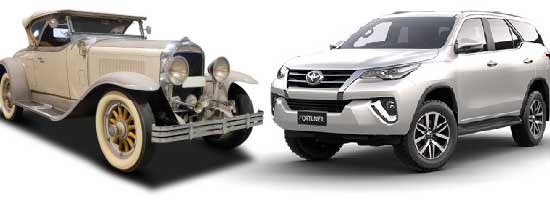Karl Benz, the brain behind the first gas engine automobile in 1886 which produced 0.75 horsepower, had no idea of the impact his blueprint would have on his then unforeseeable future. A few years later, just before the 1920’s, Ford, General Motors and Chrysler emerged as the “Big Three” auto companies, producing cars that had a revolutionary output of approximately 35 horsepower, producing 20 miles per hour. Yes, 20 miles per hour, they must have had some thrill with that back then!
Imagine driving a car that could only go as fast as the speed limit set in a housing complex; a car with no air conditioning, no safety mechanisms, no Bluetooth technology, no radio, no computer systems check, no car Wi-Fi, no sensors, no car phone, no car refrigerator compartment; and for the futuristic, no self-parking feature cars nor ability to plug your motor car into the wall. Almost one hundred years later and we the consumers are faced with the difficulty of having to pick, choose and refuse what we do or do not want in our personal motor vehicle from over 55 brands worldwide.

One hundred years ago, motor car engines only ignited from one fuel, gasoline, until Mercedes Benz revolutionised the game in 1936 by introducing the ‘Mercedes-Benz 260 D’ which ran on diesel. Gasoline and diesel engines lasted for almost a century until environmental health concerns were raised worldwide. The likes of Tesla and BMW, who fittingly celebrate their 100th anniversary this year, created a new avenue for a significantly cleaner way of fueling a car. BMW Vision Efficient Dynamics currently has two major plug in hybrid motor cars on the market, namely the i8 and the i3. Though not fully electric, containing turbo diesel engines, they have completely revolutionised the way we fuel cars today.
Whoever is quick to say these electric vehicles are slower than the average car and cannot go the distance on one charge, must quickly eat their words. Tesla’s unique Model S electric car is amongst the quickest street legal motor vehicles in the world, clocking 0-60 mph in just 2.5 seconds, quicker than a BMW M5. I’m sure Karl would not have even fathomed such a thing back in the late 19th century.

Coupled with speed, there has been significant developments with the onset of automatic transmission which most new generation drivers take for granted. The first automatic transmission based vehicle was developed in 1940 but those were rare and carried an overwhelming price tag, thereby leaving manual/standard motor vehicles as the more popular option for many decades. There has been the
To continue reading, purchase Vol.8 #10, 2017 Issue.


Share this post:
Karl Benz, the brain behind the first gas engine automobile in 1886 which produced 0.75 horsepower, had no idea of the impact his blueprint would have on his then unforeseeable future. A few years later, just before the 1920’s, Ford, General Motors and Chrysler emerged as the “Big Three” auto companies, producing cars that had a revolutionary output of approximately 35 horsepower, producing 20 miles per hour. Yes, 20 miles per hour, they must have had some thrill with that back then!
Imagine driving a car that could only go as fast as the speed limit set in a housing complex; a car with no air conditioning, no safety mechanisms, no Bluetooth technology, no radio, no computer systems check, no car Wi-Fi, no sensors, no car phone, no car refrigerator compartment; and for the futuristic, no self-parking feature cars nor ability to plug your motor car into the wall. Almost one hundred years later and we the consumers are faced with the difficulty of having to pick, choose and refuse what we do or do not want in our personal motor vehicle from over 55 brands worldwide.
One hundred years ago, motor car engines only ignited from one fuel, gasoline, until Mercedes Benz revolutionised the game in 1936 by introducing the ‘Mercedes-Benz 260 D’ which ran on diesel. Gasoline and diesel engines lasted for almost a century until environmental health concerns were raised worldwide. The likes of Tesla and BMW, who fittingly celebrate their 100th anniversary this year, created a new avenue for a significantly cleaner way of fueling a car. BMW Vision Efficient Dynamics currently has two major plug in hybrid motor cars on the market, namely the i8 and the i3. Though not fully electric, containing turbo diesel engines, they have completely revolutionised the way we fuel cars today.
Whoever is quick to say these electric vehicles are slower than the average car and cannot go the distance on one charge, must quickly eat their words. Tesla’s unique Model S electric car is amongst the quickest street legal motor vehicles in the world, clocking 0-60 mph in just 2.5 seconds, quicker than a BMW M5. I’m sure Karl would not have even fathomed such a thing back in the late 19th century.
Coupled with speed, there has been significant developments with the onset of automatic transmission which most new generation drivers take for granted. The first automatic transmission based vehicle was developed in 1940 but those were rare and carried an overwhelming price tag, thereby leaving manual/standard motor vehicles as the more popular option for many decades. There has been the
To continue reading, purchase Vol.8 #10, 2017 Issue.
Share this post: